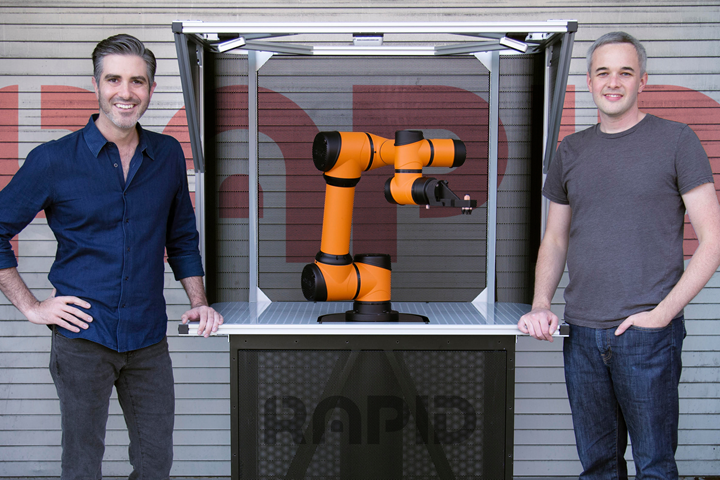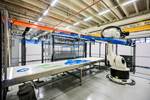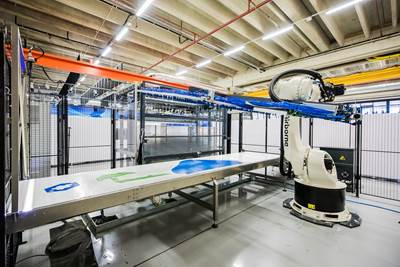Rapid Robotics earns additional $12 million in Series A funding
Rapid Robotics to product more than 50 million parts, including RMO all-in-one robotics solution to perform common machine operating tasks like injection molding and pick-and-place.

Rapid Robotics CEO Jordan Ruddick (left) with the Rapid Machine Operator. Photo Credit: Rapid Robotics
On April 6 Rapid Robotics (San Francisco, Calif., U.S.) announced $12 million in Series A funding led by New Enterprise Associates (NEA), with existing investors Greycroft, Bee Partners and 468 Capital also participating. The latest investment brings Rapid Robotics’ total funding to $17.5 million, with Rapid’s solutions producing more than 50,000,000 parts over the past year across almost every industry sector including plastics, metals, medical devices, automotive, pharma, semiconductors and electronics/EMS.
According to Rapid Robotics, its entry into the market comes at a pivotal moment for U.S. manufacturing, as the Biden administration rolls out ambitious plans to revitalize the sector, boosting competitiveness in areas including automotive, pharmaceuticals, public health and semiconductors.
But these efforts face a serious challenge: a chronic shortage of factory workers. Rapid Robotics says Deloitte estimates that by the end of the decade, U.S. manufacturers may have 2.4 million jobs they cannot fill, putting $454 billion of business at risk.
The shortfall is especially acute with machine operators, the employees who work the machines that perform 80% of all factory tasks. By some accounts, U.S. manufacturers need 600,000 more operators to meet demand and compete with factories overseas.
The Rapid Machine Operator is an all-in-one robotics solution that comes ready to perform common machine operating tasks like injection molding, pad printing, heat stamping, pick-and-place and dozens of others.
“If we don’t solve this problem, U.S. manufacturers will never be able to compete in a global market,” says Rapid Robotics CEO Jordan Kretchmer. “It’s really that simple.”
Until recently, says the company, manufacturers were caught between a scarcity of machine operators and an inability to automate. “Robotics made sense for large-scale assembly-line jobs with decades-long windows for ROI, but not for operating the manufacturing machines that do most of the work on factory floors,” says NEA General Partner and former Silicon Graphics (Milpitas, Calif., U.S.) CTO Forest Baskett. “Robots cost too much to begin with and even more to train. The numbers just didn’t pencil out.”
Rapid Robotics says it changed this “automation equation” with the Rapid Machine Operator, said to be the first affordable robotics solution for automating machine tasks. Now its biggest problem is keeping up with demand.
“I’ve been in manufacturing for more than 20 years, and the enthusiasm for the Rapid Machine Operator is like nothing I’ve ever seen,” says Mike Lewis, head of sales and marketing at Rapid Robotics, and former VP of business development at global technology, supply chain and manufacturing company Flex (Singapore). “When we meet with potential customers, at first they’re skeptical because they’ve been burned by vendors who couldn’t deliver. When they see what the Rapid Machine Operator can do, they start to get excited. By the end of the visit, they just want to know how soon we can get RMOs in place.”
The Rapid Machine Operator is an all-in-one robotics solution that comes ready to perform common machine operating tasks like injection molding, pad printing, heat stamping, pick-and-place and dozens of others. Unlike other robots, Rapid Robotics says, the Rapid Machine Operator arrives complete with machine vision and pretrained AI, so it can get to work in less than a day. And it gains capabilities over time, as the entire Rapid Machine Operator fleet shares expertise and new skills through the cloud.
Each RMO is controlled via tablet — no robotics expertise required — and can be easily repurposed for new tasks as the need arises, using 3D-printed grippers that can be fabricated onsite for no additional charge.
With Rapid Machine Operators available by subscription for less than $2,100/month, manufacturers are said to increase profits by an average of $110 thousand per year for each unit installed, and reach positive ROI almost immediately as a result of Rapid’s innovative OpEx pricing model, allowing them to successfully bid for work that previously would have gone overseas.
“It’s hard to overstate the economic implications of the Rapid Machine Operator,” says Aaron Jacobson, partner at NEA. “After looking at numerous robotics startups in America and beyond, only Rapid Robotics had the right technology focused on the right needs to make a broad-based, immediate impact on the competitiveness of U.S. companies.”
Recent Rapid Robotics customers include TouchMark (Hayward, Calif., U.S.), Fabri-Tech (Fremont) and Applied Engineering (South San). Rapid Robotics customers report their RMOs have not only helped them win contracts but also to increase headcount and transition existing employees to less repetitive, higher-value, more satisfying work.
“We process many parts and have to expedite jobs frequently for our customers, but were struggling to keep adequately staffed to meet the demand. The highly precise process requires three human operators each day, which limited our ability to meet the customer’s needs and to take on new work,” says Ryan Gagne, engineering manager at TouchMark. “When we brought in Rapid's RMOs, we were able to upskill those employees to execute other more complex tasks and to oversee the new robotic workforce. Using Rapid Machine Operators on these simple tasks has also increased our capacity and reduced lead times for our customers.”
“The Rapid Machine Operator flips the typical automation narrative on its head,” Kretchmer adds. “It doesn’t just increase productivity, it boosts employment. By bringing manufacturing work back onshore, Rapid Machine Operators are actually helping businesses create jobs for American workers.”
Related Content
Bio-inspired EV underbody panel developed by TPI Composites, Helicoid Industries
Composite underbody panel for battery pack protection, made of stacked multiaxial noncrimp fabric, will serve high-volume commercial and automotive markets.
Read MoreBroetje-Automation demonstrates rCF placement via AFP
Through the ScrapSeRO project, the system integrator and machine builder successfully processed recycled composites, in addition to more traditional materials, via its highly flexible Staxx One system.
Read MoreMcClarin Composites partners with ExxonMobil to accelerate high-speed RTM
Multimillion-dollar investment to drive next-gen automated RTM technology will open new applications and markets for composites OEMs.
Read MoreLarge-format 3D printing enables toolless, rapid production for AUVs
Dive Technologies started by 3D printing prototypes of its composite autonomous underwater vehicles, but AM became the solution for customizable, toolless production.
Read MoreRead Next
Airborne, JETCAM develop digital interface for automated kitting
Integration of Airborne’s automated kitting solution and JETCAM’s CrossTrack software provides seamless data exchange for automated kitting of composite plies.
Read MoreAll-recycled, needle-punched nonwoven CFRP slashes carbon footprint of Formula 2 seat
Dallara and Tenowo collaborate to produce a race-ready Formula 2 seat using recycled carbon fiber, reducing CO2 emissions by 97.5% compared to virgin materials.
Read More“Structured air” TPS safeguards composite structures
Powered by an 85% air/15% pure polyimide aerogel, Blueshift’s novel material system protects structures during transient thermal events from -200°C to beyond 2400°C for rockets, battery boxes and more.
Read More
























